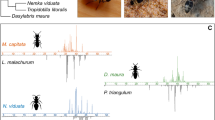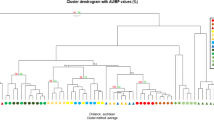Abstract
Parasitoids often use complex cues to identify suitable hosts in their environment. Phorid fly parasitoids that develop on one or a few host species often use multiple cues, ranging from general to highly specific, to home in on an appropriate host. Here, we describe the hierarchy of cues that Pseudacteon phorid flies use to identify Azteca ant hosts. We show, through behavioral observations in the field, that phorid flies are attracted to two cryptic Azteca species, but only attack Azteca sericeasur (Hymenoptera: Formicidae: Dolichoderinae). To test whether the phorid flies use cuticular hydrocarbons (CHCs) to distinguish between the two Azteca taxa, we first documented and compared cuticular hydrocarbons of the two Azteca taxa using gas chromatography/mass spectrometry. Then, using cuticular hydrocarbon-transfer experiments with live ants, we characterized the cuticular hydrocarbons of A. sericeasur as a short-range, host location cue used by P. lasciniosus (Diptera: Phoridae) to locate the ants.





Similar content being viewed by others
References
Askew RR (1971) Parasitic insects. American Elsevier, New York
Braganca MAL, Nogueira CA, Souza LM, Della Lucia TMC (2009) Superparasitism and host discrimination by Neodohrniphora elongata (Diptera: Phoridae), a parasitoid of the leaf-cutting ant Atta sexdens rubropilosa (Hymenoptera: Formicidae). Sociobiology 54:907–918
Brandt M, van Wilgenburg E, Sulc R, et al. (2009) The scent of supercolonies: the discovery, synthesis and behavioural verification of ant colony recognition cues. BMC Biol 7:71
Brown BV, Feener DH (1991) Behavior and host location cues of Apocephalus paraponerae (Dipter: Phoridae), a parasitoid of the giant tropical ant Paraponera clavata (Hymenoptera: Formicidae). Biotropica 23:182–187
Brown BV, Philpott SM (2012) Pseudacteon parasitoids of Azteca instabilis ants in Southern Mexico (Diptera: Phoridae; Hymenoptera: Formicidae). Psyche A J Entomol 2012:1–6
Chen L, Sharma KR, Fadamiro HY (2009) Fire ant venom alkaloids act as key attractants for the parasitic phorid fly, Pseudacteon tricuspis (Diptera: Phoridae). Naturwissenschaften 96:1421–1429
Choe DH, Ramírez SR, Tsutsui ND (2012) A silica gel based method for extracting insect surface hydrocarbons. J Chem Ecol 38:176–187
Consoli FL, Wuellner CT, Vinson SB, Gilbert LE (2001) Immature development of Pseudacteon tricuspis (Diptera: Phoridae), an endoparasitoid of the red imported fire ant (Hymenoptera: Formicidae). Ann Entomol Soc Am 94:97–109
Disney RHL (1994) Scuttle flies: the Phoridae. Chapman & Hall, London
Feener DH, Brown BV (1993) Oviposition behaviora of an ant-parasitizing fly, Neodohrniphora curvinervis (Diptera: Phoridae), and defense behavior by its leaf-cutting ant host Atta cephalotes (Hymenoptera: Formicidae). J Insect Behav 6:675–688
Feener DH, Brown BV (1997) Diptera as parasitoids. Annu Rev Entomol 42:73–97
Feener DH, Jacobs LF, Schmidt JO (1996) Specialized parasitoid attracted to a pheromone of ants. Anim Behav 51:61–66
Gazal V, Bailez O, Viana-Bailez AM (2009) Mechanism of host recognition in Neodohrniphora elongata (Brown) (Diptera: Phoridae). Anim Behav 78:1177–1182
Gilbert LE, Morrison LW (1997) Patterns of host specificity in Pseudacteon parasitoid flies (Diptera: Phoridae) that attack Solenopsis fire ants (Hymenoptera: Formicidae). Environ Entomol 26:1149–1154
Godfray HC (1994) Parasitoids: behavioral and evolutionary ecology. Princeton University Press, Oxford
Liang D, Silverman J (2000) You are what you eat: diet modifies cuticular hydrocarbons and nestmate recognition in the Argentine ant, Linepithema humile. Naturwissenschaften 87:412–416
Longino JT (2007) A taxonomic review of the genus Azteca. Zookeys:1–63
Mathis KA, Philpott SM (2012) Current understanding and future prospects of host selection, acceptance, discrimination, and regulation of Phorid Fly Parasitoids that attack ants. Psyche (Cambridge) 1–9
Mathis KA, Philpott SM, Moreira RF (2011) Parasite lost: chemical and visual cues used by Pseudacteon in search of Azteca instabilis. J Insect Behav 24:186–199
Morehead SA, Feener DH (2000) Visual and chemical cues used in host location and acceptance by a dipteran parasitoid. J Insect Behav 13:613–625
Perfecto I, Vandermeer J, Philpott SM (2014) Complex ecological interactions in the coffee agroecosystem. Annu Rev Ecol Evol Syst 45:137–158
Pesquero MA, Campiolo S, Fowler HG, Porter SD (1996) Diurnal patterns of ovipositional activity in two Pseudacteon fly parasitoids (Diptera: Phoridae) of Solenopsis fire ants (Hymenoptera: Formicidae). Florida Entomol 79:455–457
Philpott SM (2005) Trait-mediated effects of parasitic phorid flies (Diptera: Phoridae) on ant (Hymenoptera: Formicidae) competition and resource access in coffee agro-ecosystems. Environ Entomol 34:1089–1094
Philpott SM, Perfecto I, Vandermeer J, Uno S (2009) Spatial scale and density dependence in a host parasitoid system: an arboreal ant, Azteca instabilis, and its Pseudacteon phorid parasitoid. Environ Entomol 38:790–796
Porter SD (1998) Host-specific attraction of Pseudacteon flies (Diptera: Phoridae) to fire ant colonies in Brazil. Florida Entomol 81:423–429
Porter SD, Fowler HG, Campiolo S, Pesquero MA (1995) Host specificity of several Pseudacteon (Diptera: Phoridae) parasites of fire ants (hymenoptera: Formicidae) in South America. Florida Entomol 78:70–75
R Development Core Team (2013) A language and environment for statistical computing. R Development Core Team, Vienna, Austria. Available at http://www.R-project.org.
Reese KM, Philpott SM (2012) Environmental and habitat drivers of relative abundance for a suite of Azteca -attacking Pseudacteon phorid flies. Environ Entomol 41:1107–1114
Silva VSG, Bailez O, Viana-Bailez AM, et al. (2008) Survey of Neodohrniphora spp. (Diptera: Phoridae) at colonies of Atta sexdens rubropilosa (FOREL) and specificity of attack behaviour in relation to their hosts. Bull Entomol Res 98:203–206
Torres CW, Brandt M, Tsutsui ND (2007) The role of cuticular hydrocarbons as chemical cues for nestmate recognition in the invasive Argentine ant (Linepithema humile). Insect Soc 54:363–373
Van Lenteren, JC (1981) Host discrimination by parasitoids. In: Semiochemicals: Their role in pest control. Wiley, New York
Vinson SB (1976) Host selection by insect parasitoids. Annu Rev Entomol 21:109–133
Wuellner CT, Dall’aglio-Holvorcem CG, Benson WW, Gilbert LE (2002) Phorid fly (Diptera: Phoridae) oviposition behavior and fire ant (hymenoptera: Formicidae) reaction to attack differ according to phorid species. Ann Entomol Soc Am 95:257–266
Acknowledgments
We thank Finca Irlanda for allowing us to conduct research on the farm and SEMARNAT (Secretaria de Medio Ambiente y Recursos Naturales) for permission to collect and export samples and J. Rojas and E. Chamé Vasquez for facilitating the process of acquiring permits. Research was supported by the National Science Foundation fellowship (GRFP DGE 1106400), USDA National Institute of Food and Agriculture Hatch project (CA-B-INS-0087-H), the Van den Bosch research fellowship, and the UC Mexus dissertation research grant. Research reported in this publication was supported by the National Institute of General Medical Sciences of the National Institutes of Health under Award Number K12GM000708. The content is solely the responsibility of the authors and does not necessarily represent the official views of the National Institutes of Health.
Author information
Authors and Affiliations
Corresponding author
Electronic Supplementary Material
Fig. S1
Plot of average number of Pseudacteon lasciniosus and Pseudacteon planidorsalis phorid flies to arrive to pygidial gland bioassays with Azteca sericeasur pygidial gland extracts (SER), A. JTL020 pygidial gland extracts (JTL) or a hexane control (Control). Different letters atop bars indicate means that are different (P < 0.05). (PDF 133 kb)
Rights and permissions
About this article
Cite this article
Mathis, K.A., Tsutsui, N.D. Cuticular Hydrocarbon Cues Are Used for Host Acceptance by Pseudacteon spp. Phorid Flies that Attack Azteca sericeasur Ants. J Chem Ecol 42, 286–293 (2016). https://doi.org/10.1007/s10886-016-0694-y
Received:
Revised:
Accepted:
Published:
Issue Date:
DOI: https://doi.org/10.1007/s10886-016-0694-y




